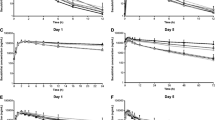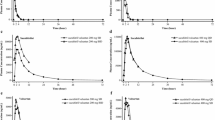Summary
The conventional pharmacokinetic profile of the angiotensin converting enzyme (ACE) inhibitor, enalapril, is a lipid-soluble and relatively inactive prodrug with good oral absorption (60 to 70%), a rapid peak plasma concentration (1 hour) and rapid clearance (undetectable by 4 hours) by de-esterification in the liver to a primary active diacid metabolite, enalaprilat.
Peak plasma enalaprilat concentrations occur 2 to 4 hours after oral enalapril administration. Elimination thereafter is biphasic, with an initial phase which reflects renal filtration (elimination half-life 2 to 6 hours) and a subsequent prolonged phase (elimination half-life 36 hours), the latter representing equilibration of drug from tissue distribution sites. The prolonged phase does not contribute to drug accumulation on repeated administration but is thought to be of pharmacological significance in mediating drug effects.
Renal impairment [particularly creatinine clearance <20 ml/min (<1.2 L/h)] results in significant accumulation of enalaprilat and necessitates dosage reduction. Accumulation is probably the cause of reduced elimination in healthy elderly individuals and in patients with concomitant diabetes, hypertension and heart failure.
Conventional pharmacokinetic approaches have recently been extended by more detailed descriptions of the nonlinear binding of enalaprilat to ACE in plasma and tissue sites. As a result of these new approaches, there have been significant improvements in the characterisation of concentration-time profiles for single-dose administration and the translation to steady-state. Such improvements have further importance for the accurate integration of the pharmacokinetic and pharmacodynamic responses to enalapril(at) in a concentration-effect model. This model is able to characterise the concentration-effect relationship in individual recipients of the drug and predict the antihypertensive responses to dosage alterations.
Therapeutic use of enalapril has recently expanded to include heart failure. In this condition, responses to enalapril may be mediated by different effector systems in different organs and may occur at different concentration ranges to those observed during treatment of hypertension. However, similar concentration-effect analyses are still relevant. After almost 15 years of clinical use, the therapeutic applicability of enalapril continues to expand and detailed pharmacokinetic description of the agent remains an integral component of this expansion.
Similar content being viewed by others
References
Abrams WB, Davies RO, Gomez HJ. Clinical pharmacology of enalapril. Journal of Hypertension 2 (Suppl. 2): 31–36, 1984
Aldigier JC, Huang H, Dalmay F, Lartigue M, Baussant T, et al. Angiotensin converting enzyme inhibition does not suppress plasma angiotensin II increase during exercise in humans. Journal of Cardiovascular Pharmacology 21: 289–295, 1993
Baba T, Murabayashi S, Tomiyanma T, Takebe K. The pharmacokinetics of enalapril in patients with compensated liver cirrhosis. British Journal of Clinical Pharmacology 29: 766–769, 1990
Baba T, Tomiyama T, Murabayashi S, Tomiyama M, Takebe K. Enalapril pharmacokinetics in diabetic patients. Lancet 1: 226–227, 1989
Cohn JN, Johnson G, Zieche S, Cobb F, Francis G, et al. A comparison of enalapril with hydralazine-isosorbide dinitrate in the treatment of chronic congestive heart failure. New England Journal of Medicine 325: 303–310, 1991
CONSENSUS Trial Study Group. Effects of enalapril on mortality in severe congestive heart failure: results of the Cooperative North Scandinavian Enalapril Survival Study. New England Journal of Medicine 316: 1429–1435, 1987
Cleland JGF, Gillen G, Dargie HJ. The effects of frusemide and angiotensin converting enzyme inhibitors and their combination on cardiac and renal haemodynamics in heart failure. European Heart Journal 9: 132–141, 1988
Davies RO, Gomez HJ, Irvin JD, Walker JF. An overview of the clinical pharmacology of enalapril. British Journal of Clinical Pharmacology 18 (Suppl. 2): 215S–229S, 1984a
Davies RO, Irvin JD, Kramsch DK, Walker JF, Moncloa F. Enalapril worldwide experience. American Journal of Medicine 77: 23–35, 1984b
Dickstein K, Till AE, Aarsland T, Tjelta K, Abrahamsen AM, et al. The pharmacokinetics of enalapril in hospitalized patients with congestive heart failure. British Journal of Clinical Pharmacology 23: 403–410, 1987
Donnelly R, Meredith PA, Elliott HL, Reid JL. Kinetic-dynamic relations and individual responses to enalapril. Hypertension 15: 301–309, 1990
Ehlers MRW, Riordan JF. Angiotensin converting enzyme: new concepts concerning its biological role. Biochemistry 28: 5311–5317, 1989
Francis RJ, Brown AN, Kler L, Fasanella d’Amore T, Nussberger J, et al. Pharmacokinetics of the converting enzyme inhibitor cilazapril in normal volunteers and the relationship to enzyme inhibition: development of a mathematical model. Journal of Cardiovascular Pharmacology 9: 32–38, 1987
Fruncillo RJ, Rocci Jr ML, Shepley K, Clementi RA, DeRita R, et al. Enalapril accumulates after chronic enalapril dosing in renal failure. Abstract no. A50. Clinical Pharmacology and Therapeutics 37: 197, 1985
Hayes PC, Plevris JN, Bouchier IAD. Pharmacokinetics of enalapril and lisinopril in subjects with normal and impaired hepatic function. Journal of Human Hypertension 3: 153–158, 1989
Hockings N, Ajayi LAA, Reid JL. Age and the pharmacodynamics of the angiotensin converting enzyme inhibitors enalapril and enalaprilat. British Journal of Clinical Pharmacology 21: 341–348, 1986
Hodsman GP, Isles CG, Murray GD, Usherwood TP, Webb DJ, et al. Factors related to first dose hypotensive effect of captopril: prediction and treatment. British Medical Journal 286: 832–834, 1983
Irvin JD, Till AE, Vlasses PH. Bioavailability of enalapril maleate. Clinical Pharmacology and Therapeutics 33: 248, 1984
Johnston CI, Jackson BJ, Larmour I, Cubella R, Casley D. Plasma enalapril levels and hormonal effects after short- and long-term administration in essential hypertension. British Journal of Clinical Pharmacology 18 (Suppl. 2): 233S–239S, 1984
Juillerat L, Nussberger J, Menard J, Mooser V, Christen Y, et al. Determinants of angiotensin II generation during converting enzyme inhibition. Hypertension 16: 564–572, 1990
Kawamura M, Imanashi M, Matsushima Y, Ito K, Hiramori K. Circulating angiotensin II levels under repeated administration of lisinopril in normal subjects. Clinical and Experimental Pharmacology and Physiology 19: 547–553, 1992
Kelly J, Doyle G, Donohoe J, Laher M, Vandenburg MJ, et al. The pharmacokinetic profile of enalaprilat in normal subjects and patients with renal impairment. British Journal of Clinical Pharmacology 18: 274P, 1984
Kelly J, Doyle G, Donohoe J, Laher M, Vandenburg MJ, et al. Chronic dose pharmacokinetics of enalapril in renal impairment. British Journal of Clinical Pharmacology 20: 264P–265P, 1985
Larmour I, Jackson B, Cubella R, Johnstone CI. Enalapril (MK421) activation in man: importance of liver status. British Journal of Clinical Pharmacology 19: 701–704, 1985
Lees KR, Kelman AW, Reid JL, Whiting B. Pharmacokinetics of an ACE inhibitor S9780 in man: evidence of tissue binding. Journal of Pharmacokinetics and Biopharmaceutics 17: 529–550, 1989
Linz W, Shaper J, Wiemer G, Albus U, Schwalkens BA. Ramipril prevents left ventricular hypertrophy with myocardial fibrosis without blood pressure reduction: a one year study in rats. British Journal of Pharmacology 107: 970–975, 1992
Lowenthal DT, Saris SD, Haratz A, Packer J, Porter RS, et al. The clinical pharmacology of antihypertensive drugs. Journal of Hypertension 2 (Suppl. 2): 49–56, 1984
MacFadyen RJ, Lees KR, Reid JL. Studies with low dose intravenous diacid ACE inhibitor (perindoprilat) infusions in normotensive male volunteers. British Journal of Clinical Pharmacology 34: 115–121, 1992
Meredith PA, Donnelly R, Elliott HL, Howie CA, Reid JL. Prediction of the antihypertensive response to enalapril. Journal of Hypertension 8: 1085–1090, 1990
Motwani JG, Fenwick MK, Morton JJ, Struthers AD. Frusemide induced natriuresis is augmented by ultra low dose captopril but not by standard doses of captopril in chronic heart failure. Circulation 86: 439–445, 1992
Odemuyiwa O, Gilmartin J, Kenny D, Hall RJC. Captopril and the diuretic requirements in moderate and severe chronic heart failure. European Heart Journal 10: 586–590, 1989
Ohnishi A, Tsuboi Y, Ishizaki T, Kubota K, Ohno T, et al. Kinetics and dynamics of enalapril in patients with liver cirrhosis. Clinical Pharmacology and Therapeutics 45: 657–665, 1989
Pfeffer MA, Braunwald E, Moyé LE, Basta L, on behalf of the SAVE investigators. Effect of captopril on mortality and morbidity in patients with left ventricular dysfunction after myocardial infarction. New England Journal of Medicine 327: 669–677, 1992
Reid JL, Meredith PA. Concentration effect analysis of antihypertensive drug response. Hypertension 16: 12–18, 1990
SOLVD Investigators. Effect of enalapril on survival in patients with reduced left ventricular ejection fractions and congestive heart failure. New England Journal of Medicine 325: 293–302, 1991
Saris S, Lowenthal D, Klein L, Irvin JD, Merrill D, et al. Enalapril maleate in renal failure. Abstract No. A15. Clinical Pharmacology and Therapeutics 35: 272, 1984
Schwartz JB, Taylor A, Abernethy D, O’Meara M, Farmer J, et al. Pharmacokinetics and pharmacodynamics of enalapril in patients with congestive heart failure and patients with hypertension. Journal of Cardiovascular Pharmacology 7: 767–776, 1985
Swanson BN, Vlasses PH, Ferguson RK, Bergquist PA, Till AE, et al. Influence of food on the bioavailability of enalapril. Journal of Pharmaceutical Sciences 73: 1655–1657, 1984
Sweet CS, Ulm EH. Enalapril. In Scriabine (Ed.) New drugs annual: cardiovascular drugs, Vol. 2, pp. 1–17, Raven Press, New York, 1984
Till AE, Gomez HJ, Hichens M, Bolognese MS, Lant AF. Pharmacokinetics of repeated single oral doses of enalapril maleate in normal volunteers. Biopharmaceutics and Drug Disposition 5: 273–280, 1984
Todd PA, Goa KL. Enalapril: a reappraisal of its pharmacology and therapeutic use in hypertension. Drugs 43: 346–381, 1992
Ulm EH. Enalapril maleate (MK-421), a potent, non-sulphydril angiotensin-converting enzyme inhibitor: absorption, disposition and metabolism in man. Drug Metabolism Review 14: 99–110, 1983
Ulm EH, Hichens M, Gomez HJ, Till AE, Hand E, et al. Enalapril maleate and a lysine analogue (MK-521) disposition in man. British Journal of Clinical Pharmacology 14: 357–362, 1982
Weisser K, Schloos J, Lehmann K, Dusing R, Vetter H, et al. Pharmacokinetics and converting enzyme inhibition after morning and evening administration of oral enalapril to healthy subjects. European Journal of Clinical Pharmacology 40: 95–99, 1991
Yusef S, Pitt B, Davis CE, Hood WB, Cohn JN, for the SOLVD investigators. Effects of enalapril on mortality and the development of heart failure in asymptomatic patients with reduced left ventricular ejection fractions. New England Journal of Medicine 327: 685–691, 1992
Author information
Authors and Affiliations
Rights and permissions
About this article
Cite this article
MacFadyen, R.J., Meredith, P.A. & Elliott, H.L. Enalapril Clinical Pharmacokinetics and Pharmacokinetic-Pharmacodynamic Relationships. Clin. Pharmacokinet. 25, 274–282 (1993). https://doi.org/10.2165/00003088-199325040-00003
Published:
Issue Date:
DOI: https://doi.org/10.2165/00003088-199325040-00003




